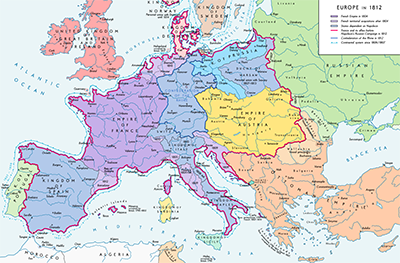The War of the Sixth Coalition
Part 1: A Grand Alliance The War of the Sixth Coalition involved a number of other European countries fighting against France in the early 19th Century. Unlike earlier coalition wars, this one was a marked victory for the Allies. The War of the Fifth Coalition had ended in late 1809, with France extracting almost humiliating terms from Austria. No large-scale fighting occurred in Central Europe for a few years. In fact, across Europe, the only exception to the relative peace was the Peninsular War, in Portugal and Spain. 
For a variety of reasons economic, military, and political, France had invaded Russia in 1812. The massive Grand Armée met with nearly complete disaster, with fewer than 100,000 of the 650,000 who marched off to war in Russia making it back. Having forced the French Army out of Russia, the Russian military command got busy with pursuit. Russian troops would fight against French troops again but again as part of a coalition. 
Officers in the Prussian and Russian forces in late December 1812 hammered out the Convention of Tauroggen, which severed the enmity that existed between the two powers because Prussia was technically allied with France. That initial understanding led to the Treaty of Kalisch, which added Sweden and the United Kingdom to the list of powers dedicated to opposing France. Thus, on Feb. 28, 1813, was born the Sixth Coalition. Sardinia and Sicily eventually joined as well. Sweden declared war on France on March 3; the Prussian declaration of war came two weeks later. While the remnants of the Grand Armée staggered back out of Russia, the French emperor Napoleon Bonaparte had traveled more quickly back to Paris, amid reports of an attempted coup. He had enough support left in the capital to nullify any challenge to his authority or his crown. In the meantime, however, the other powers of Europe had united against him more than ever before. France still had a large population (including allies) at this time, and Bonaparte was able to put together another large army, this one numbering 400,000. In May 1813, French troops won two significant battles, at Lützen and Bautzen, involving large total numbers of troops than had yet been seen. The significance for France was that the victories resulted in a cease-fire. However, French losses for both battles combined were about as much as for the Allies. During this time as well, French troops were losing battles and territory in Spain. The Peninsular War, which Bonaparte had sparked by instigating a coup in Spain, had dragged on for five years and had consumed large amounts of manpower and munitions that could have been employed elsewhere. The transfer of tens of thousands of troops from the Spanish war to the invasion of Russia didn't help either effort, in the end. The cease-fire lasted from June to August. During that time, the Allies succeeded in enlisting Austria to join the Sixth Coalition. By this point, the main French and allied force numbered 650,000, about the same size as the army that had invaded Russia; on the other side resided nearly 800,000 Allied troops in the main force. Next page > Allied Victory > Page 1, 2 |
|
Social Studies for Kids
copyright 2002–2026
David White




